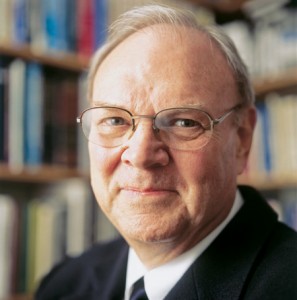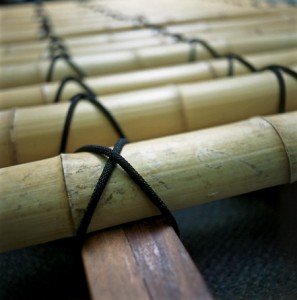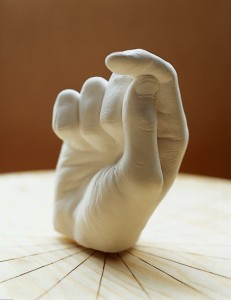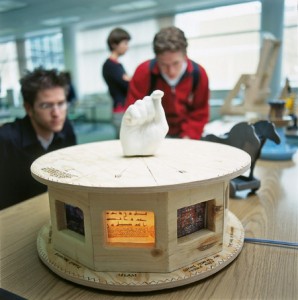A recognized expert in all things plastic, Brent Strong regularly morphs between specialties as diverse as engineering, business management, and the history of creativity.

Brent Strong | Photo by Bradley H. Slade, ’94
That milk carton in the fridge is made of high-density polyethylene for a reason—it needs to stand up and keep its shape. The garbage bag it winds up in when empty is made of low-density polyethylene so it can remain flexible.
“Can you imagine making a milk carton with low-density polyethylene?” Professor A. Brent Strong asks BYU students during an early fall class discussion on the fundamentals of plastics. “It would just plop in the refrigerator like a bag.
This is basic stuff, belying the expertise Strong has in the field. He’s BYU’s plastic man—flexible enough intellectually to excel in research, business, and teaching, rigid enough organizationally to succeed as an inventor, author, and consultant. Remember the old Bo Jackson TV commercials, which hyped the football and baseball player’s incredible ability at more than one sport? “Bo knows baseball” or “Bo knows football.” Well, Brent knows plastics. And Brent knows business. He also happens to know creativity and teaching. The way he conducts his entry-level plastics classes is evidence of his masterful teaching. In his classrooms, everything has a clear application.
“If you open a bottle of pills often enough, and it’s made of polyethylene, you get a whitening, called blushing, around the lid and the lip of the bottle, and it gets brittle and eventually falls apart,” Strong tells the class. “Polypropylene isn’t like that. It’s flex-fatigue resistant. If you want a living hinge, you want polypropylene as that hinge.
Despite his skill in his current vocation, Strong didn’t set out to be a teacher. He wanted to be an innovator in the world of plastics. Somehow along the way he ended up at BYU as both.
From Plastics to Professorship
It wasn’t a midlife crisis. He didn’t have a problem with his boss. He was making good money. In fact, Strong was doing exactly what he wanted with his career—working for DuPont on the cutting edge of plastics.
“It was wonderful,” he says. “It was fantastic. I was always in new products.
“The snag in his dream job was location. If DuPont hadn’t decided to transfer him from California back to Delaware, where he started, Strong might never have wound up at BYU, where he regularly dresses up as Aristotle or Plato for lectures and is the 2003 Karl G. Maeser Distinguished Faculty Lecturer.
In the late 1970s Strong and his wife, Margaret, were well on their way to building a family of eight children, and they had come to enjoy California’s proximity to family and friends in Utah. When DuPont asked him to return to the East Coast, they said no.
It wasn’t an easy decision for Strong to sever ties with DuPont—”I loved DuPont”—in favor of a California competitor, and it didn’t take long for his new job to gain an additional measure of discomfort. He didn’t know that Reed Irrigation Systems was in financial trouble or that it had a serious technical problem with its product, irrigation tubing that was prone to crack. Fortunately, an Australian company stepped in, purchased Reed, and sent a manager to see if it could be salvaged. The man decided the company was viable, in part because Strong had solved the technical issue, and he soon asked Strong if he would serve as president.
The position would be a move away from being the full-time plastics expert he wanted to be, but Strong said yes. Then his new boss explained that he wanted the company to have a 40-percent gross margin.
“OK,” Strong said. “What’s gross margin?
“The manager stared at him in disbelief. Then he shook his head and said, “Oh, I think I made a mistake.”
Instead of simply leaving everything to the scientist, the manager took Strong under his mentoring wing, and the duo turned the company around. For five years, Strong ran the company, which became Hardie Irrigation Systems, and the experience began to mold his plastics career into something more academic in nature. “I wanted to teach what I wish I would have been taught in school,” he says. So in 1986, after a two-year stint at another company, he accepted a position at BYU. “In the technical arena, I wanted to teach plastics, which I was never taught in school. And the other was a minor in business. I would have liked to have known what gross margin was.”
Driving Ambition
Strong lines up his socks according to color in alphabetical order. His children tease him about it, but he doesn’t do it out of an eccentric need for order. He believes it saves precious time.
“He’s not crazy about it,” Margaret Strong says. “He just doesn’t waste time. He takes care of the details of his life in a very regimented way so he doesn’t have to worry about them.
“More than anything, it’s emblematic of his ambition, a drive that makes life around Brent Strong vibrant and exciting.
“He’s so busy he can’t afford to lose keys,” Margaret says. “He’s very focused and has incredible drive.
“When friends pitched a multilevel- marketing opportunity to the Strongs, they employed the traditional opening: “If you had all the time and money in the world, what would you do?
“It’s a loaded question, one designed to appeal to dreamers and to elicit feelings of inadequacy or to drum up remorse over lost opportunity. It didn’t work on Strong. What would he do if he could do anything? “What I’m doing,” he said.
How could that be? his friends asked. Strong’s answer laid bare his personality: “I don’t wish for things. If there’s something I want, I make it happen.
“He’s been that way for a long time. When he married Margaret while a sophomore at the University of Utah, friends asked what he wanted to do when he finished school. “We’re going to live in Delaware and work for DuPont,” he said.
When he completed his doctorate at the U, the time came for the long-anticipated interview in Delaware. Strong left Utah a few days early so he could cold-call at companies in Pennsylvania and New Jersey. After walking in off the street at A Chemical (now Allied Chemical), he left with a big surprise—a job in his back pocket in case DuPont fell through. But it wasn’t Strong who was surprised; it was the manager who offered the job.
“The manager said, ‘We don’t recruit anybody from Utah,'” Strong recalls. “‘The only reason I’m making this offer is I’ve never had a PhD in chemistry come cold-calling.'”
Renaissance Man

Professor Brent Strong examines a bamboo bed made by Brad A. Woods, ’04, a student in Strong’s history of creativity class. Every student in the class must create a major project to be displayed on “Creativity Day.” Photo by Bradley H. Slade, ’94.
Be careful about trying to place Brent Strong in a neat intellectual category. His PhD in physical chemistry came with an emphasis on nuclear magnetic resonance, but he’s not an unapproachable theoretician or an overorganized academician. In fact, he’s one of a dozen or so professors who volunteered to teach an experimental course for freshmen this fall. The class is designed to give young BYU students a chance to connect strongly with a faculty member in the first few weeks of school. If the experiment is a success, it could be included in new requirements being written by the university’s general-education committee, on which Strong has served for five years.
Each Friday for the first half of the fall semester, Strong met with about a dozen freshmen who all read a book of his choice, Creating, by Robert Fritz. In one hour during a September class discussion, the young scholars-in-training discussed Elie Wiesel, Neal A. Maxwell, Beethoven, Goethe, Van Gogh, Hemingway, Poe, Tchaikovsky, Mozart, and Stravinsky. This was the Strong colleagues call “Renaissance Man”—the Strong who dresses up as Greek philosophers and who advises major corporations on how to avoid killing off employee creativity. It’s the same man who, with partners, holds 10 patents and who has written five books on plastics.
He dons Greek garb so he can speak with the voices of Aristotle and Plato and challenge his students with their philosophies.
“My belief is the Apostasy happened, in part, because of Greek thinking,” he says. “The concept of the Trinity in the Nicean Creed is like reading Plato’s concept of the Form, an intangible thing known only in your mind.
“He also lectures as Machiavelli.
“I don’t want to say, ‘Machiavelli said.’ I want to go face-to-face with the class to get them thinking about what Machiavelli was saying.”
Breadth and Depth
“My career goal, initially, was to be very, very deep in plastics,” Strong says. “Suddenly I was thrust into a very broad situation where I had to know a lot about business. When I came to BYU, I knew how to get promoted academically: go deep into research. So in my career I first went deep, then broad, then deep. It was fun. I like to know where the edge is. I think I can see the edge of our knowledge in plastics.

Strong says, creativity spans all disciplines, and thus the class fosters breadth of knowledge and experience. Photo by Bradley H. Slade, ’94.
“But in the early 1990s, while Strong was chair of BYU’s Department of Manufacturing Engineering and Engineering Technology, the department was criticized in a self-study as being too isolated. So Strong went broad again, reaching out to the rest of the university. He got involved with the new general- education mandate for history of civilization courses across the university. Students must study civilization “in any one of 10 flavors, and they choose whatever flavor they like,” Strong says. For his history of civilization course, he decided, “the twist is going to be creativity, because creativity is the common thread between technology, science, arts, and humanities. If people are good, they are usually creative in one of two ways, either in the creative application of logic and skill or the creative application of analogies, metaphors, and unique insights.
“A few years later, BYU split Strong’s department and created the School of Technology; Strong chose to move with the technology group. “Technology is where we use science to change the world, hopefully for the benefit of mankind,” he says. “Engineering, while viable, was focused too much on theory and didn’t fulfill my desire to teach what I’d wanted to know in school. So I switched to manufacturing engineering technology.
“The move opened for Strong another opportunity to build breadth, and soon he was fulfilling his dream to prepare students with both technical knowledge and business savvy. “We give students a minor in business as well as a strong background in engineering,” he says. BYU’s Marriott School of Management gave Strong a professorship, the Lorin Farr Professor of Entrepreneurial Technology, to create a strong link between the university’s business and technology schools.
In addition to a minor in business, Strong decided BYU’s program needed a real learning experience—internships. In 1999 he created the Manufacturing Leadership Forum (MLF), which now partners with more than 80 companies around the country to provide hands-on opportunities for BYU students.
“What we propose is to assist manufacturing-engineering students to bridge the gap to the real world, because nobody does manufacturing outside the world of business,” Strong says. “The MLF helps students prepare for their internship and then capitalize on that experience.”

Strong’s creativity class allows students – like Benjamin S.Hudson, ’06, who created the project above – to explore an idea and subject in depth. Photo by Bradley H. Slade, ’94.
“Businesses are looking for a student who has applied technical skills within a business-school context so they have someone who can help move and lead processes,” says Dixon W. Abell, ’77, president and CEO of a Louisiana company called PolyProcessing. Abell is a BYU business graduate whose father earned an engineering degree at Georgia Tech. He thought the ideal degree would combine the two, and he gave BYU $1 million to help Strong establish the MLF. “It’s hard to find good leadership, and if you take a young person grounded in the LDS culture and who’s been part of the BYU system and has good energy and knowledge, you’ll have a good leader.”
Response to the program has been positive from both students and industry representatives. Corporations like Intel, Toyota, ProModel, and Westwind Aircraft have signed on to host students. For Abell, it’s obvious why industry leaders are interested in BYU. “We need leaders who have applied engineering skills, and I think Brent has developed a formula for producing students with that background,” Abell says. “It’s one thing to generate a student who graduates and another to bring a graduate to the market who can make an impact.”
Practical Plastics
Strong’s creativity extends to titles of papers he’s written for scholarly publications. He wrote “Why Engineers Should Read Shakespeare” and co-authored “If It Don’t Make ¢ent$, It Don’t Make Sense: Can the Internet Help You Profit?” Both were published by a journal for which Strong has been a contributing editor since 1996, Composites Fabrication, which in June 2003 carried an article by Strong titled, in part, “Lost in Space: Creating an Environment on Earth for Building Safe and Effective Space Structures.”
Among dozens of other articles that show Strong’s breadth are “Composites in Weapons and Armor” and “The Precarious Entrepreneur: Where’s the Help?
“His depth is evident in the fact that he has had a hand in securing eight patents (and filing three others), writing seven books, and publishing nearly 100 articles. In October 2003 he and two colleagues were granted European Patent No. 0729573 for “Determination of the Extent of Crosslinking Prior to the Intentional Curing of Polymers.”
Obviously, that and other products of Strong’s elastic intellect seem obscure, but the common thread through his entire body of work is practicality.
When a student’s father needed insight into purchasing plastic garbage cans for Provo City, Strong developed tests to evaluate the wheels, handles, lids, weight, volume, and even the force required to tip them over. After publishing the results, he began to field calls from cities around the nation that wanted him to analyze their garbage-can fleet. Thus were born the impact test, squeeze test, crash-recovery test, wind-tunnel test, and flammability test. There was even a drag test, where BYU students drew strange looks as they pulled garbage cans behind their cars.
Strong’s expertise has attracted corporate and government attention. Dozens of organizations have provided him with research funds totaling more than $2.5 million since he arrived at BYU, including a $975,000 grant from McDonnell Douglas for a study of composite materials. He’s been given money to conduct research on everything from artificial-limb development and fiberglass shrouds for ATMs to composite golf clubs and skis.
“I’ve really been blessed,” Strong says. “Working in plastics and working at BYU have been wonderful.”
Proficient Pedagogy
As a teacher, Strong isn’t flashy, if you discount the Greek robes. He isn’t loud or excitable. He’s just . . . interesting. And effective.
Back in the classroom, Strong is talking about PVC. Ever left PVC pipe out in the sun until it’s time to put in the sprinkling system only to have it turn a yellowish brown? he asks. That’s a sign the plastic (polyvinyl chloride) is degrading. Even more interesting, PVC has been outlawed in Germany over concerns that it is made of a deadly poison, vinyl chloride. The Green Party enacted legislation to phase in a ban on its use in Germany.
“That’s wild,” Strong tells the class. “It’s one of the three or four biggest polymers in the world, and it may not be allowed in Germany.”
One mixture in the process of making PVC is so deadly that three or four drops in a classroom would kill everyone, Strong says. But beyond that point in the manufacturing process, PVC is safe, though it does degrade easily in the sun or when attacked by a solvent or even hot water.
“That’s why most of your homes don’t have PVC for hot water,” Strong says. “You have copper or something else. PVC is for cold water.”
Oh, and by the way, PVC is hard and stiff, right? Strong asks. Well, how about PVC with plasticizer? It’s vinyl, and Germany’s banning that, too. Expect more leather in BMWs and Mercedes, he says. Who knows what Volkswagen will do?Margaret, a veteran of her husband’s classes, says that simple, accessible style is why a University of Utah professor told Strong it would be a waste of talent for him to go out into industry instead of teaching.
“He’s always able to take a complex topic and make it easy to understand,” she says. “He can anticipate what the roadblock will be for the person he’s teaching and help that person around it. Teaching is about getting outside yourself and how you learned a subject. For a lot of students, it’s Greek to them. He’s able to speak whatever language his students are speaking.”
Windows on the World
Some people long for an office with a view. Not Brent Strong. His office is located in the center of the Crabtree Technology Building and has no windows.
Just the way he likes it.
“It’s a wonderful office,” he says. “There are no windows, so I can have more books.
“This isn’t the stereotypical professor’s office, crammed with books that appear to be cascading off the shelves and across desks and chairs and onto the floor. In Strong’s office, order rules. Two walls bear shelves heavy with volumes on technology and history. One wall is organized as the “Wall of Depth”—the technology side—and the other is the “Wall of Breadth”—the business and creativity section.
“I know within a foot where every book is on those shelves,” he says. “They are all arranged in order.
“An office window would provide a static view anyway. When Strong wants to see something, he wants it to be something new. One of his hobbies is travel, which grew out of his decision to start teaching courses on the history of creativity and his desire to strengthen his relationship with Margaret.
“We decided we were not going to have a life that depends only on having children around to have something to talk about,” Strong says. “We consciously decided to have a common hobby: the history of civilization.”
So once a year, Margaret takes the evening section of her husband’s creativity class. After class they go to dinner and she provides critiques; then they drive home to Sandy, 30 minutes north of Provo. They often spend some of that time planning an overseas trip, to the Louvre or the Vatican museum, for example.
A few years ago, the Strongs decided to take each of their eight children and his or her spouse on a trip anywhere they want to go in the world.
“We want to do it so we can develop relationships with our kids as adults, not just at the parent-child level,” Strong says. They’ve made five trips so far, going once or twice a year. The next one will be to either New Zealand, Italy, or central Germany.
Strong uses the trips in class: “If you just say, ‘I’m going to do the Louvre,’ and you just walk around, you’ll be there for a week,” he told his History of Creativity class this fall. “So I always plan where I’m going to go.
“He pulled up a slide of the Winged Victory of Samothrace, a sculpture of Nike created about 190 B.C. and found on the Greek island of Samothrace. “When I go see ‘Winged Grace’ at the Louvre,” he continued, “I sit on a little low wall and look at this beautiful sculpture. I’ll tell you what I see—I see movement, for the first time. Classic Greek sculpture was all static poses. She’s walking and the wind is blowing her gown. It’s better in real life than you can imagine. It takes my breath away.
“Students feel transported by Strong’s firsthand accounts of human creativity—”I try to use pieces of art I’ve seen and that I’m emotionally involved with,” he says—and many contact him in the months and years after taking his class to ask his advice on their own travel.
Wherever he goes, so go books. He’s always reading two at a time, he says. He just finished Six Thinking Hats, by Edward de Bono. He’s now reading C. P. Snow’s The Two Cultures, which addresses the notion that our society is characterized by a split between the cultures of the arts or humanities on one hand and the sciences on the other, and a Harvard Business Review book titledBreakthrough Thinking.
He doesn’t just read, either. He marks important passages and notes them on the blank pages in the back of the book. When he finishes, he types the cross-references into his database. That way, the books don’t go on the shelves to be forgotten. From his database he can pull thoughts for lesson plans, thus sharing the walls of depth and breadth with his students in much the same way he shares his travels with them.
It’s the organized attention to detail—be it a database of ideas, an ordered sock drawer, or a planned bookshelf—that enables Strong to effortlessly morph from a scientist to a businessman to a scholar to a teacher, and back again. With the tools at his fingertips, he can readily access them for the task of the moment. Such versatility, combined with a dedication to young people, makes Strong an effective professor, one whose teaching in windowless rooms opens new windows on the world for BYU students.
Tad Walch is the Utah County Bureau chief for the Deseret News. feedback: Send comments on this article to magazine@byu.edu






